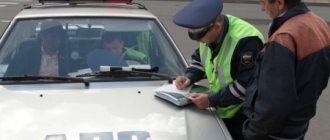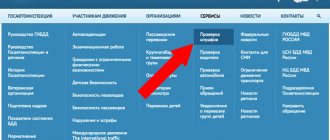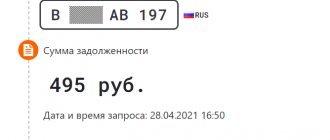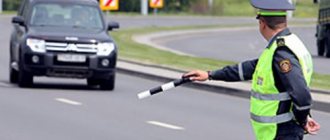How are traffic fines paid?
The traffic police issues a resolution. The driver was speeding and the camera noticed it. It automatically sends a photo of the violation to the traffic police server. The traffic police officer receives the photo from the server and checks it. If there are no errors in the data about the driver and the car, he issues a decision.
The fine appears in the database. Information about the violation remains in the traffic police database and is duplicated in the state information system on state and municipal payments (GIS GMP).
The driver pays. As soon as the driver pays the fine, information about the payment will be sent to the GIS GMP.
The fine has been paid. After this, the debt disappears from the traffic police database - the driver has no debts on fines.
If the payment was made through “Traffic Police Fines”, the payment history is saved
Is it possible to pay the traffic police fine in installments?
Yes, the fine can be paid in installments. In paragraph 6 of the instructions for users of the GIS GMP database it is stated that there can be several payments for one accrual.
This can be done if the payer knows the payment details and is ready to patiently enter them in the bank terminal or in the bank application. You can find out the details in two ways:
- from a paper decree,
- on the State Services website.
Let's look at both options.
A paper order arrived. On the resolution form, after the description of the violation, there are details that can be used to pay the fine.
Using the details in the paper order, you can pay the fine at any bank. Example from 11.mvd.rf
An electronic fine has arrived. In the upper right corner of the State Services website, click on your name and initials and select “Review”.
Find the fine in your service history and click on it. A page with details will open.
Next, click “All details” - a window with details will open.
In case of partial payment, the money does not always reach the recipient. To prove payment, keep payment receipts.
It’s easier to pay the fine through special services - all you need is a car number and a vehicle registration certificate. You can pay in the first 20 days at a discount.
What are the consequences for the driver?
What happens if you pay a fine of 1 ruble and it doesn’t go through? There are no direct fines or other types of penalties for attempting to use such a payment scheme. The legislation of 2021 does not prohibit you from partially paying the sanctions.
But there are consequences to simply being late on your payments. And according to reviews about paying 1 ruble, most of these cunning car enthusiasts ended up doing just that. This is not surprising, because those who try to deceive the system in this way are essentially trying to avoid paying debts in every possible way... And they do not pay them until the last minute.
Let's look at a couple of consequences!
Double penalty
It is assigned to a driver who has delayed payment of the main sanction as a separate punishment for such a fact of delay. And it is provided for by part 1 of article 20.25 of the Code of Administrative Offences.
But such a punishment is more commonly called a “double fine” than is correct. Because the norm of this article provides for doubling the amount as a mild form of punishment. And there is an even tougher one - administrative arrest for up to 15 days.
Now we explain how this article actually works in case of partial payment. If you paid 1 ruble for a fine, for example, 500 rubles for speeding, then the debt is not repaid, since you still owe 499 rubles. The fine will not go away, and as of 2021 this is true.
After 70 days have passed (10 days for the resolution to come into force plus 60 days for payment), you begin to be in arrears. It is from this moment that the composition appears to attract you under 20.25 of the Administrative Code. But this composition does not last indefinitely, but for 3 months - this is already the statute of limitations for attraction.
Thus, if you decide that you can pay 1 ruble for the assigned sanction, then one of the measures may await you within the specified period:
- a new double fine of the overdue amount (but not less than 1000 rubles),
- arrest up to 15 days,
- compulsory work up to 50 hours.
Please note that if you, for example, paid 1 ruble for a fine of 2000 rubles (let it be for a pedestrian) and thus owe 1999, then if a double fine is imposed you will be awarded not 1999 × 2 = 3998 rubles, but 4000, because the amount assigned is based on the amount of the fine, and not on the unpaid amount.
Agree, an excellent lesson: we tried to save money, but ended up with an amount multiplied by 3 from the first fine (after all, the obligation to repay the remaining amount of the first one also did not go away, plus a double fine was imposed).
Something else useful for you:
- If you fled the scene of an accident? Punishment, what to do and how does it work?
- Will I have to pay double the fine? Calculation procedure
- Is it possible and how to drive tinted without getting fines and arrest?
Reviews
In one of the cases, a lady driver allegedly accidentally paid 1 ruble instead of the required 500, as a result the case went to court.
The magistrate decided to consider the case under Article 20.25 and summoned the defendant to a hearing demanding clarification about payment of a fine of 1 ruble. Of course, there is nothing to explain here objectively for her own protection, so she was assigned another 1000 rubles.
But this is not the only consequence of trying to pay a ruble instead of the due amount. Let's look at another one!
Collection by bailiffs
Everything here is also quite simple. If you do not pay the fine on time (within the same 70-day period), then it is subject to forced execution by the bailiff service. This measure of influence goes in parallel with the possibility of attraction under Article 20.25 of the Administrative Code. And its period is 2 years - during this period the bailiffs can collect the balance of the unpaid fine:
- from your bank card,
- offer to pay in cash,
- against the property in proportion to the unpaid fine.
And also impose a registration ban and seizure of the car.
How to submit applications to pay a fine in installments
The law allows you to ask for installments for three months. Such a request must be sent to the traffic police inspector who issued the resolution.
To write an application. In your application, write the reason why you cannot pay the fine on time. Such a reason could be a difficult financial situation, illness, loss of a job or debt obligations to the bank. Complete the application with documents: a bank statement or a certificate from a medical institution.
Collect documents. You will need:
- copy of the passport,
- copy of the resolution,
- application for installment plan,
- certificates confirming insolvency.
The inspector will review the application within 30 days.
There are exceptions when you cannot ask for an installment plan or deferment:
- speeding fine;
- fine for transporting people or goods on vehicles not registered in the Russian Federation;
- fine for violating the requirements of signs and markings;
- fine for non-payment to the Platon system - for trucks heavier than 12 tons.
Payment of a fine for deprivation of rights due to alcohol intoxication
You will have to pay 30,000 rubles if you drive a car while intoxicated. A fine and deprivation of rights are a measure of deprivation that can be imposed when an offense is recorded by a traffic police officer. A protocol must be drawn up that determines the fact of a violation. Based on it, a decision is made, according to which a fine is paid.
Grounds for deprivation of a license and a fine of 30,000 rubles
| № | Situation | Peculiarities |
| 1 | Driving a car while intoxicated | The results are recorded in an official conclusion |
| 2 | Narcotic, psychotropic intoxication when driving | An examination is being carried out |
| 3 | Refusal of medical examination | This is indirect evidence of exceeding the permissible levels of alcohol, the presence of drugs in the blood |
| 4 | Transferring control to a drunk driver | Equivalent to drunken driving |
| 5 | Use of illegal drugs after an accident until the completion of the examination | The use of psychotropic and narcotic drugs and alcohol is prohibited. It will not be considered a violation to receive them at the end of the examination. |
On a note!
Repeated driving while intoxicated, after deprivation of the license, threatens the offender with severe financial sanctions in the range of 200,000 - 300,000 rubles. In this case, the right to drive is limited for 3 years. They may also impose compulsory labor for up to 480 hours or forced labor/imprisonment for up to 2 years. These measures provided for in Art. 264.1 of the Criminal Code of the Russian Federation.
In a state of alcohol or drug intoxication, or under the influence of psychotropic drugs, the driver loses control and cannot adequately assess the situation on the road. After an accident, the offender will have to pay a fine in the future. An additional penalty is deprivation of your license for driving while intoxicated.
What if the case goes to court and the fine is too high?
Alexander Torvard, auto lawyer Almost always a large fine is accompanied by deprivation of rights - and this is always a court case. It is at the trial that you can ask for an installment plan. In this case, of course, attach evidence of insolvency.
The court considers violations when, for example, the driver was drunk or left the scene of an accident. At the court hearing, voice your request and support your words with documents:
- application for installment plan;
- expected payment schedule;
- documents that confirm the impossibility of paying the fine.
If the judge takes into account all the explanations, the payment period will be increased to three months.
Also, the law allows you to ask for a delay of a month.
What if the payment was not completed in full?
If, during the check, the status of the fine remains “Unpaid,” then it still exists in the GIS GMP database.
This can happen for several reasons:
- the bank did not transmit payment information;
- the payer made a mistake with the details;
- failure in GIS GMP.
If the last fine payment did not go through, follow these steps:
- collect all checks and receipts from the bank;
- request information about them from the bank and make sure that the bank transferred the money according to the details;
- send payment documents to the traffic police by registered mail or with a personal visit.
- wait for a response. Duration: 10 days.
Remember
- You can pay the fine in part, but to do this you need to know the recipient's details. They can be viewed on a paper decree or on public services.
- Even if you pay the fine in installments, you must do so within 70 days from the date of the decision.
- If the fine is large and there is no money to pay, write an application for installment payment and submit it to the person who is considering the violation case - an inspector or a judge.
- If you paid in installments and the fine has not been paid off in the traffic police database, check that the details are correct. If everything is correct, send checks and receipts to the traffic police by registered mail or with a personal visit.
All articles by the author: Evgeniy Lesnov
How to pay fines in installments?
Art. 32.2 of the Code of Administrative Offenses establishes that the full amount of the fine must be paid within 60 days after the decision to impose the fine comes into force.
This formulation has several subtleties:
- The law does not stipulate that the fine must be paid in one payment. During the term, money can be transferred at least every day. The main thing is that the amount of all transfers is equal to the amount of the fine.
- Secondly, the article talks about a 60-day period. But this period is counted from the moment the resolution comes into force, and this occurs 10 days from the moment the violator is notified. Thus, in total, the driver has 70 days to collect the entire amount.
Important! Many traffic fines are eligible for a 50% discount when paid within the first 20 days. If possible, you should borrow money and use it - this will significantly reduce your debt burden.









